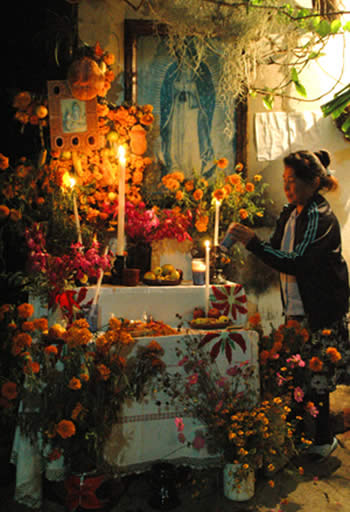
Credit: mexicansugarskull.com
The Mexican Day of the Dead is actually celebrated over two days, Nov.1 and Nov. 2, in Central and Southern Mexico. Legend holds that at midnight on Oct. 31, the gates of heaven fly open and release the souls of those who died in infancy or childhood to visit their families. That is why Nov. 1 is referred to as “Dia de los Innocentes.” The spirits of adults who have died arrive the next day, on “Dia de los Muertos.”
Northern Mexicans usually do not celebrate the Day of the Dead, though many do celebrate the Catholic holiday of All Saints Day on Nov.1. Some aspects of the Day of the Dead are celebrated in other Spanish-speaking countries as well.
The Day of the Dead began as a holiday celebrated by the Aztecs. It was originally a festival to the goddess Mictecachihuetl who was said to have died at birth. The holiday evolved over the years as Catholic missionaries arrived and enforced their own beliefs and holidays.
Today, the Day of the Dead is seen as a chance to remember and reconnect with family and friends who have passed on. Unlike in the United States, where death is considered frightening, and spirits, or ghosts, are scary, in Mexico, death is considered a normal part of the cycle of life. In fact, life is seen as a dream while death is seen as reality. Instead of being a terrifying event, a visit from a spirit is considered a sign of good luck and wisdom.

Credit: mexicansugarskull.com
The celebrations for Day of the Dead are elaborate and expensive. Some families spend two months’ income creating an altar to welcome their spirits home. Each household creates its own altar decorated with items such as candles, handmade drapes, marigolds, the red combs of roosters and the loved ones’ favorite foods. On Nov. 1, the family places toys on the sacred space so that spirit children can play. On Nov. 2, cigarettes and shots of alcohol are placed out for the adult spirits. Another common item on the altar is the sugar skull. Family members carve their deceased loved ones’ names into the skull and then give them to children to eat toward the end of the festivities.
In the afternoon of Nov. 2, celebrants go to the village graveyard. There, they tidy their loved ones’ graves and leave offerings like flowers or food. This is a time to reminisce and solidify relationships among the living. Once the graves are cared for, many of the villagers stay to help other families, to visit or to play games like cards.
There are cultures where anything having to do with death is considered frightening or morbid. In Central and Southern Mexico, however, the dead are remembered with pride and good cheer. The Day of the Dead gives celebrants a chance to renew their attachments to both the deceased and the living.

 Mexico’s Day of the Dead
Mexico’s Day of the Dead


 “Songbird” by Fleetwood Mac
“Songbird” by Fleetwood Mac
 First the Wealth Gap, Now the U.S. Has a Growing Health Gap
First the Wealth Gap, Now the U.S. Has a Growing Health Gap
 How to Comfort A Dying Loved One
How to Comfort A Dying Loved One














